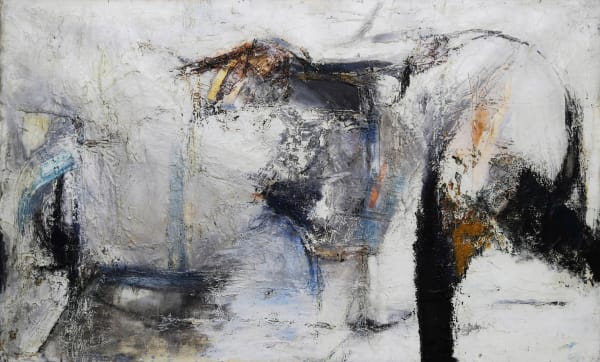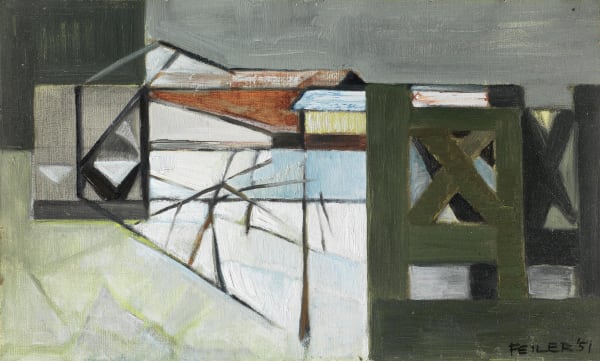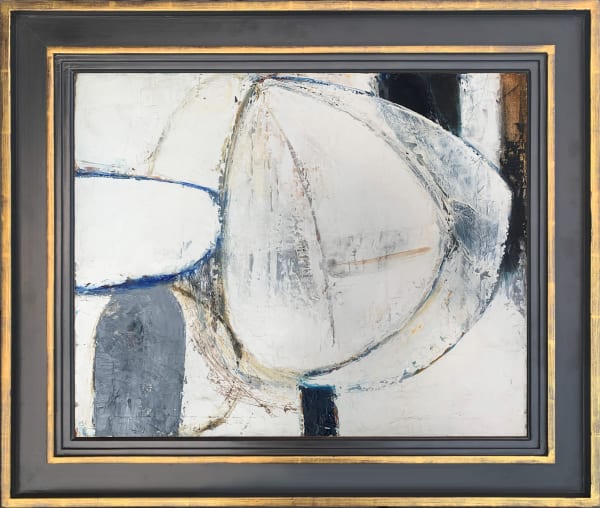Paul Feiler 1918-2013
-
 Paul FeilerPorthledden, May 1960Oil on canvas61 cm x 102 cm (24 x 40.1 ins.)
Paul FeilerPorthledden, May 1960Oil on canvas61 cm x 102 cm (24 x 40.1 ins.)
Framed: 81 cm x 122 cm (31.9 x 48 ins.)View full details -
 Paul FeilerLanding Stage Falmouth, 1951Oil on canvas board30.5 x 51 cm (12 x 20 ins.)
Paul FeilerLanding Stage Falmouth, 1951Oil on canvas board30.5 x 51 cm (12 x 20 ins.)
Framed: 45.2 x 66.5 cm (17 3/4 x 26 1/4 ins.)View full details -
 Paul FeilerFloating Forms Blue, 1963-64Oil on canvas46 x 56 cm (18.1 x 22 ins)
Paul FeilerFloating Forms Blue, 1963-64Oil on canvas46 x 56 cm (18.1 x 22 ins)
Framed: 61.5 x 71.9 cm (24.2 x 28.3 ins)View full details
"Woven into my paintings are visual memories of physical experience of a landscape, and therefore the atmospheric quality of Cornwall is there such from sea to sky. I feel I have retained this within the non-landscape pictorial concept ... One constantly travels to the coast in order to get that kind of relationship that, it seems to me, should be the Cornish quality, the Cornish atmosphere" (Paul Feiler Paintings, Tate 1995).
Paul Feiler was born in 1918 in Frankfurt-am-Main, Germany. His father, Erich Feiler was a Professor of Dentistry at Frankfurt University and the wider family were well educated with a mix of lawyers, doctors and liberal politicians. At the age of 3 Paul was given a paint box and thereafter by his own account, never ceased to paint. In the summer holidays he stayed with his grandmother in the Alps and later recalled "The emptiness had a great effect on me and has been with me ever since. It was the visual experience that gave me the sense of reality that is so remote in terms of one's existence".
In 1933, when the Nazis seized power in Germany, Paul was sent to be educated in Zwolle in the Netherlands and then to England to complete his schooling at Canford School in Dorset. In 1936 the family moved to London; his father establishing himself as a dentist in Harley Street.
Paul entered the Slade School of Fine Art in London in 1936 with soon to be peers in St Ives, Patrick Heron and Bryan Wynter. In 1939, as a so-called enemy alien and despite the family's earlier escape from Nazi Germany, Feiler was interned on the Isle of Man and subsequently sent to Canada for a year. He received his diploma from The Slade in absentia. In 1941 the designation was relaxed and Feiler returned to England gaining employment as an art teacher with Eastbourne College, which had been evacuated to and combined with Radley College in Oxford.
In 1945 Feiler married the artist June Miles; they had two daughters and a son. The following year they moved to Bristol where Paul taught at the West of England College of Art becoming the head of painting in 1960. Feiler later stated that 'talking about what I painted the night before' in class was of great importance as he responded to the stimulus of his pupils. In 1947 Feiler made the first of many painting trips to Venice.
1949 was a significant year with Feiler visiting Cornwall for the first time. Here he met up with Slade School friends Heron and Wynter and was introduced to William Scott and Peter Lanyon, who became lifelong friends. That year his work was included in The Arts Council's 'Young Contemporaries' exhibition at Bristol Art Gallery. He took part in a second exhibition 'Slade Contemporaries' with Wynter and Heron the following year.
Feiler's first solo exhibition was a sell-out at the Redfern Gallery in 1953. With the proceeds, he acquired a disused chapel at Kerris near Penzance which he converted, although spread his time between Cornwall and Bristol for some years to come. He had four more exhibitions at the renowned London gallery in the 1950s and his work was included in group shows alongside that of Wynter, Lanyon and Scott. In 'Connections', Michael Raeburn notes Feiler recalled William Scott returning from Paris in 1950 having seen the work of Nicolas de Staël and telling him about "this painter who paints in thick dabs just like you." Feiler continued "I was already using broad brushstrokes and thick paint, but now made them broader and the paint thicker. It was the handling of the paint that I found exciting." This quality distinguished Feiler's work from that of his St Ives contemporaries and paintings were soon bought by major museums; including, Large Welsh Bay which was purchased by the Arts Council of Great Britain in 1953. In 1954 The Obelisk Gallery in Washington DC presented the first of several solo exhibitions across America. During the mid-50s Feiler taught at the St Ives summer school established by Peter Lanyon and Terry Frost.
Feiler's paintings were becoming more abstracted towards the end of the decade with his Atlantic seascapes on the Cornish Coast often dominated by thick expanses of white paint struck through with slabs of dark, sometimes black pigment. In 1957 the Redfern selected Feiler for its landmark show, 'Metavisual, Tachiste, Abstract'.
During the following summer Mark Rothko made his much reported visit to Cornwall staying with Peter Lanyon and visited Feiler in Kerris. The Russian-American painter's trip made a lasting impression and the commonalities and contrasts between the 2 transatlantic abstract movements has been the subject of much conjecture ever since with some wonderful Tate Gallery exhibitions exploring that theme.
In 1958 Feiler was also part of the British Council's 'British Abstract Painting', which toured Paris, Milan, Montreal and Melbourne; and in 1961, 'British Painting in the 1960s' at the Tate.
By the early 60s Feiler's expressed aim was to visualise the experience of a given location. He commented: "Woven into my paintings are visual memories of physical experience of a landscape, and therefore the atmospheric quality of Cornwall is there such from sea to sky. I feel I have retained this within the non-landscape pictorial concept... One constantly travels to the coast in order to get that kind of relationship that, it seems to me, should be the Cornish quality, the Cornish atmosphere" (Paul Feiler in interview with Michael Tooby, for the Tate in June 1995).
Works from this period were designated by the names of features on the Cornish Coast. 'Porthledden' (May 1960), named after the bay below Cape Cornwall, is such a work. Feiler was later to remark that it was the vision of the ocean through a natural rectangular cut-out in the rocks below the Cape that had inspired him to choose this part of West Penwith to live and paint in.
In 1962 and 1965 Feiler had solo exhibitions at the Grosvenor Gallery. In 1964, Feiler showed alongside Peter Lanyon, Roger Hilton and Alan Davie at the Arnolfini Gallery, Bristol.
However, by the late 60s, his work had taken a different path; inspired by the lunar landings, he began making simplified compositions of circles and vertical bars, reminiscent of Malevich's pure Supremacist studies. Feiler was inching ever closer in his quest to capture what he termed 'elusive space'. In 1969, he painted a series of concentric squares, at the centre of which a circle was enclosed. This was the first of his so-called 'shrine' paintings, which he spent the next four decades developing and refining, taking inspiration from early sights of classical architecture from trips to Greece and Egypt. The delicate colour gradations also recall his Cornish landscapes, even if the paint by this time was applied in flat, meticulous strokes. Examples of these new paintings were unveiled as part of a solo exhibition organised by the Scottish Arts Council which toured the UK and Germany from 1980 to 1981.
Following the dissolution of his first marriage, in 1970 Feiler married the artist Catharine Armitage, another graduate of The Slade School. In 1974 they moved fulltime into the converted chapel in Kerris. Paul took over Bryan Wynter's nearby studio in Paul (fittingly a structure first converted to a studio for Stanhope Forbes at the end of the 19th century). He retired from teaching in 1983 at the age of 65 but his career as an artist was far from over; it had 30 years yet to run.
In 1990 Feiler had a major retrospective at Austin/ Desmond Fine Art in London. He went on to have further exhibitions at the Redfern Gallery; in 1993, 1998 "Janus", 1999 "Towards and Beyond" and 2002 "Connections". In 1995 the artist had a solo exhibition at the Tate St Ives "Form to Essence" with a further Tate solo exhibition taking place in 2005. Paul Feiler died in 2013 at the age of 95. Virtually every day until his death he made the short trip to his studio to paint.
Khoroche, Peter, Janicon, Redfern Gallery, 2005
O’Hear, Anthony and Raeburn, Michael, Elusive Space, Cacklegoose Press, 2010
Raeburn, Michael, Connections, Cacklegoose Press, 2002
Raeburn, Michael, Paul Feiler A Monograph, Lund Humphries, 2018
Raeburn, Michael, Works on paper, Redfern Gallery, 2014
Rouve, Pierre and O’Hear, Anthony, Lemon Street Gallery, Paul Feiler A Retropective
Tooby, Michael, Paul Feiler: Form to Essence – Theme and Development, Tate St Ives, June 1995





